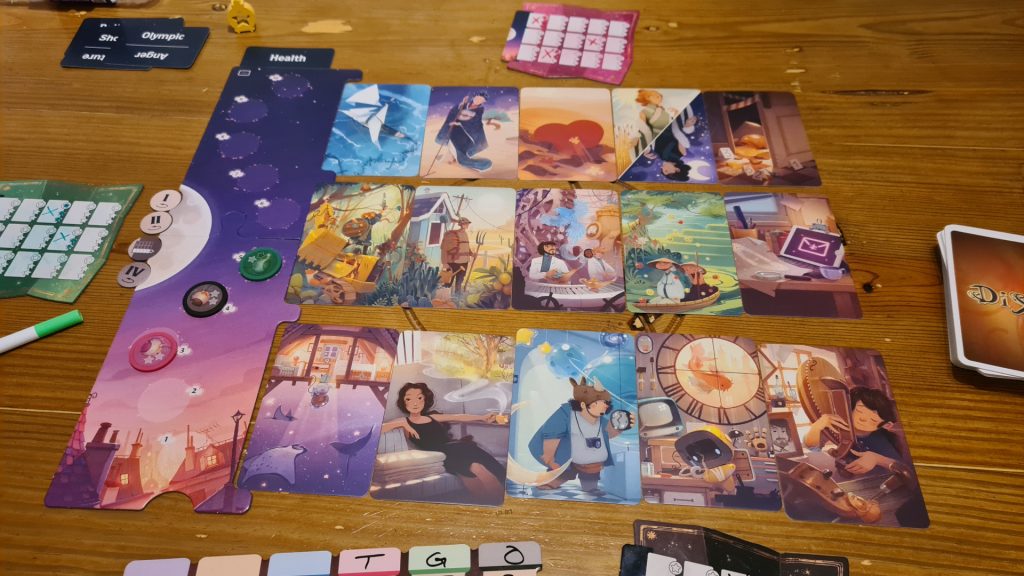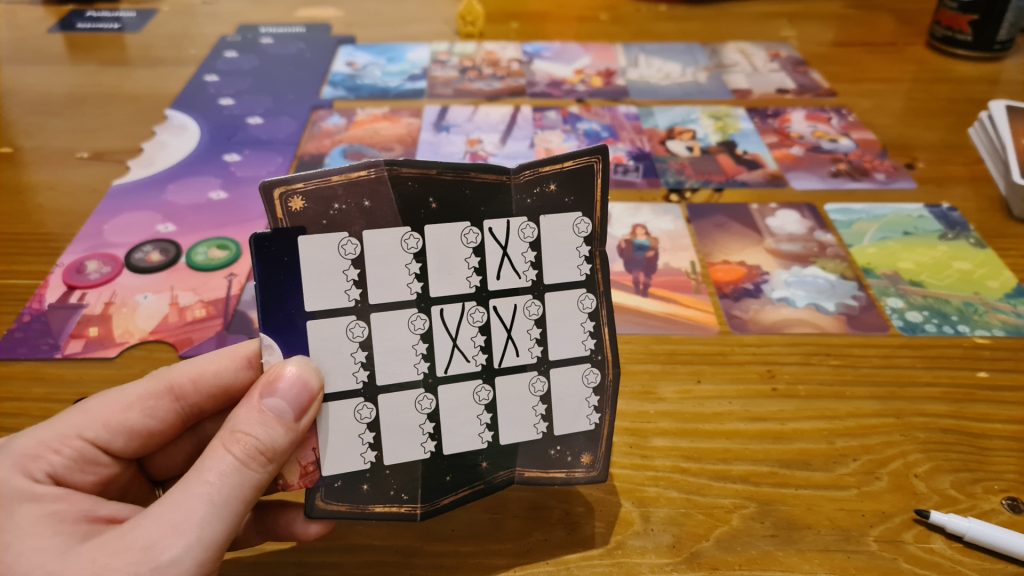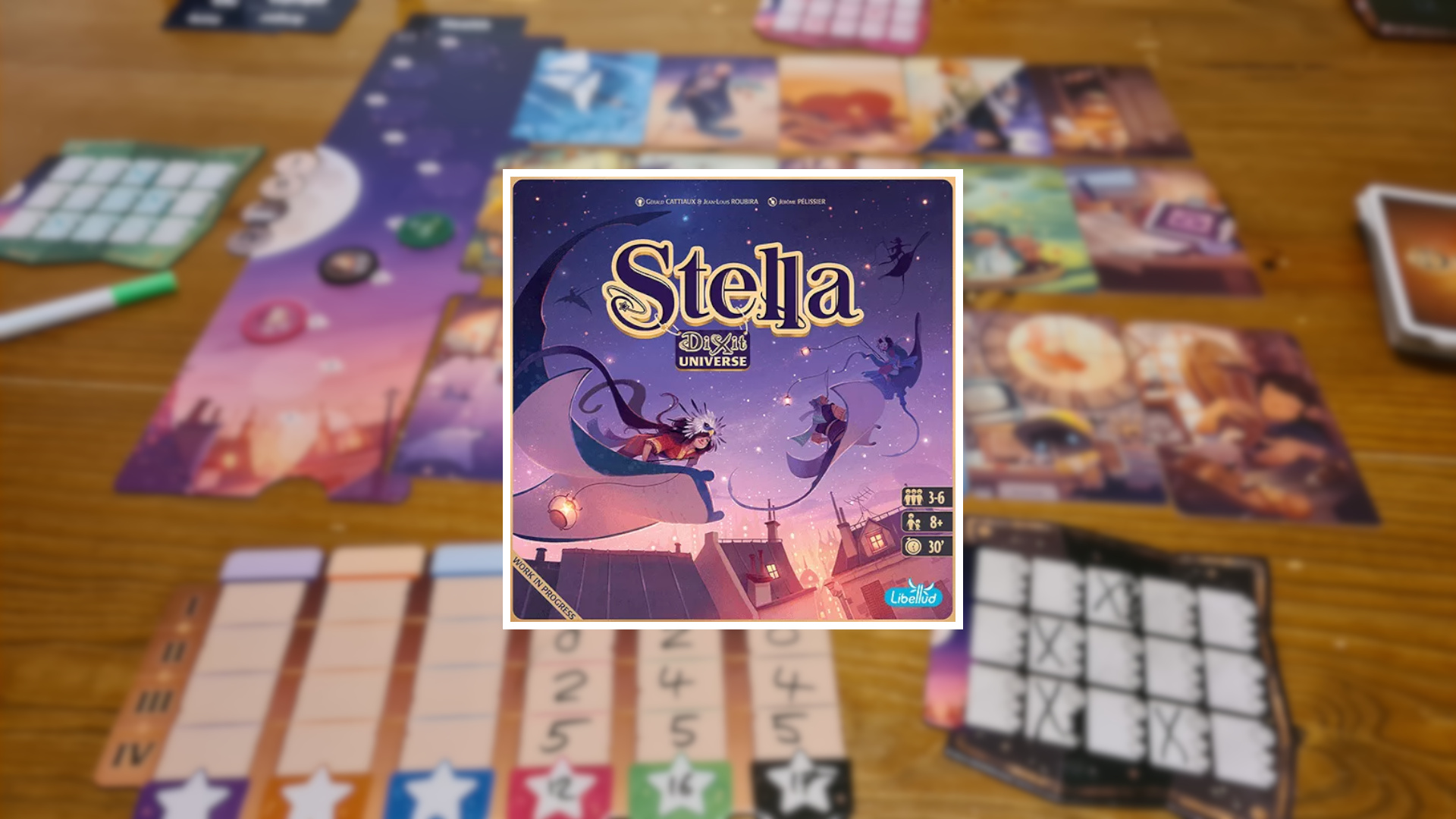Stella Dixit Universe is the brand new family party game from publisher Libellud. Designed by Gérald Cattiaux and Jean-Louis Roubira, featuring artwork from Jérôme Pélissier, the game sees 3 – 6 players utilizing the abstract artworks depicted on the Dixit style cards, with the experience revolving around word and images association. However, is this just more of the same or does it take Dixit to the next level? Let’s find out!
At the start of the game players choose a colour and take the lantern token, board and pen of matching colour. The board is placed just off to one side of the table, with 3 rows of 5 Dixit cards placed next to it. These will be the illustration cards used for round one, with some lasting for a couple of rounds. For your first game the rulebook recommends using 4 pre-selected words (Birthday, Attention, Secret and Paris). After this the words are drawn randomly from the deck, with 4 put into a stack next to the board. One player is randomly given the scout token, before the first word is revealed and the game begins!
Played over 4 rounds, each follows the same pattern. First there is a secretive associate stage. During this stage all players simultaneously look at the grid of 15 illustrated cards and determine which they think have a link to the word. For example if the word is birthday perhaps an illustration features something that represents a present/gift. For each card they think has a link players mark this, via the grid position, secretly on their personal board. Importantly, you want to mark only those you think others will also link.
Once everyone has finished this everyone announces the number of cards they have marked as linked – and this must be between 1 and 10 cards. If a single player has marked the most they are classed as “In The Dark”. If no single player has marked the most, no one is in the dark. The only impact of being in the dark is for scoring – the rest of the round is performed in the same way for all players.

Starting with the player with the scout token, they must point towards one of the Dixit cards which they marked on their board. Players will want to point towards the card which they most believe others will have also chosen. If multiple other players reveal they also choose it they all cross off two sparks out of three on their board next to that card’s position. If only one other player selected that card too then both cross off all three sparks. If no one else selected that card then the player falls. While this eliminates the player from the round, their selections can still gain the other players sparks but not themselves.
The scout token is then passed to the next player clockwise around the table. They must then choose a different card they had selected and so on. When a player should choose a card but all of theirs had been selected they are then skipped over by the scout token, as are fallen players. The round ends when everyone has fallen or is out of selected cards.
Light side players score one point for each spark they managed to collect. The player that’s in the dark scores slightly differently, depending on whether they pushed their luck too much. If all of their selections were chosen by others they score as normal, else they reduce the score they would get for each correctly selected card by 1 point (for example 3 sparks become only 2 sparks). At the end of each round a row of the Dixit cards is replaced with new cards. This could be done randomly, though tokens are included to predetermine which row is discarded. The current word is then discarded, replaced with a new one for the next round. At the end of the fourth round players points are totalled and whoever has the most points wins!
Teaching Stella would be an incredibly easy exercise if it weren’t for one slight hiccup, that hiccup being the “in the dark” scoring quirk. Word and image association is an intuitive concept to teach but how the dark side player is selected and then scores differently is a tad awkward. It takes about as long to explain the rest of the entire game as it does to explain how that player will be different. It is an interesting twist which stops players selecting a silly amount each round, though it is surprising a more streamlined method was reached.
Dixit for some has an anxiety about it. The pressure of being put on the spot to think of a word is at times detrimental to the experience of Dixit. Stella gets around this completely by including a large 90+ card deck of word cards. This huge deck unfortunately isn’t double sided. Though, aside from the 4 starter cards, each features two words allowing for an incredible amount of replayability. 10 blank cards are also included for players to write their own words down and shuffle into the mix, allowing gamers to personalize their game a bit.

Any game with Dixit-like cards ticks the stunning box thanks to the weird and wonderful abstract art which adorns the cards. In Stella the cards aren’t just like Dixit cards however, they are Dixit cards. This deck of cards would shuffle into any Dixit deck, and it would then be nigh on impossible to perfectly split them back out again. The backs of the cards are the same as standard Dixit cards and the illustrations are, as always, on top form.
Are Dixit and Stella Dixit Universe different enough to own both? There’s the change that might give less anxiety but past that there is the push your luck and the level playing field of the central spread of cards. In Dixit players could find that none of their cards worked for a given word, while others had multiple to pick between. This is gone in Stella, with everyone matching the word to the same 15 cards. Being the dark side player is risky for scoring points but so is picking cards with too abstract an association.
A big difference is that Stella seems to work better at the lower end of the player count, whilst Dixit never did. In Dixit the more players there were the more cards in the middle and the higher chance of players linking the word with the wrong illustrations. In Stella there are always the same number of cards in play. Instead, the fun comes when there is less chance of players to have picked the same, getting those perfect moments of 1 player crossovers – which is more likely to happen at 3 or 4.
Stella takes the brilliant word and image association that Dixit is loved for, and brings a new twist – which for some will elevate the experience. Players could easily use the word deck in Dixit, or just choose their own words in Stella. Combine this with the fact that the Dixit cards included are fully interchangeable with those in any Dixit box and Stella is almost a fully standalone expansion. For low player counts it’ll certainly hit the table quicker than Dixit and will entertain everyone playing. Like the very best family / party games when it finishes you’ll want to play again straight away!
(Editor’s Note: Stella Dixit Universe was provided to us by Asmodee for the review. The game is currently available from local board game stores! Find your local store here.)

